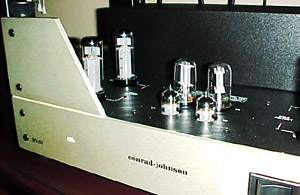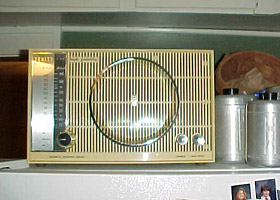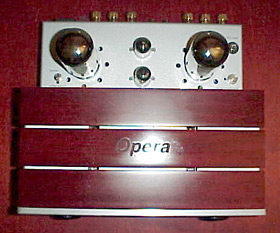![[SoundStage!]](../sslogo3.gif) Audio Hell Audio HellBack Issue Article |
March 2002 Soul for Sale What goes around comes around. Well, maybe not always. There are some things that I don’t anticipate making a comeback anytime in the near future. Let's hope that the leisure suit, the eight-track tape, and men’s pantyhose are gone for good. Tube tops, yes; tube socks, no. And speaking of tubes (what a great transition;
give the guy a Pulitzer), they're making a most-deserved comeback. You only have to open
the pages of your favorite audio rag or visit your favorite audio website (hint, hint) to
see the ever-increasing glow of firebottles. There are MANY more tube products being
manufactured today than 20 years ago. The traditional valve products like amplifiers and preamplifiers are being joined by CD players, DACs, and phono stages. I even saw an SACD player at the 2002 CES sporting a glowing bit of glass. Ron Sutherland, famous for great-sounding phono preamps, has released a tube-based preamp/DAC that hooks up to your computer. It adds what Sutherland calls "a smoothness and warmth" to digital music from your computer’s MP3 downloads. Say it isn’t so. So why are we seeing such resurgence of a technology many would refer to as antique? Why are consumers who previously displayed a phobia now getting "tubed" (this does not refer to the activity previously performed by teenage boys on unsuspecting teenage girls during the 1970s). I think the answer is soul. Those of you sitting in the sweet spot of a nice EL34-based system know exactly what I’m talking about. We live in an age of speed. Everything is moving at the pace of a bullet train with no brakes. Our technology has us living upside down. Instead of making our lives easier, allowing us to explore the beauty of life, technology has us working twice as hard at ten times the speed, with productivity requirements always one step out of reach. Digital phones, digital pagers, digital networks, digital video conferencing, digital cable modems: Does the mention of any of these products cause your shoulders to relax and your breathing to slow? And your laptop makes your life easier, right? No different than sitting in front of the fire sipping a glass of brandy? Uh huh. We need more soul in our lives. Tubes radiate soul. Tubes take us back to the time when families sat around the radio listening to big bands playing music on their non-digital instruments. I remember the big brown cast-metal AM tube radio my father kept on his workbench in the garage. It had some grounding issues and would give me a light zap on occasion. But I was always drawn to the sound of that radio. There was something rich and organic about it that I never heard through the Panasonic rack system in my bedroom. Even after I reached high school nirvana by installing the Pioneer eight-track and Jensen triaxials in my '72 Nova, something was missing. That something kept me risking electrocution to listen to old Big Brown. That something was soul. So why did we sell our souls in the '60s? For some reason the masses tend to look at anything old as bad and anything new as good. We learn this from a very young age and it sticks. Just ask a teenager about any musical group that’s been around for more than a few minutes. "They’re old," will escape his young face as it curls up like it has been fed sour milk. Manufacturers love this thought process, as it’s what keeps the cash flow flowing. Auto makers depend on us believing that a car older than four years is in need of replacing. Companies release new products all the time billed as "revolutionary" to prevent a lull in purchases. Who can blame them? Their very survival may depend on it.
When solid state came along, the world rejoiced. No maintenance, no heat, no tubes failing with two strikes, two outs, and the bases loaded. Perfect sound forever! Yeah, we’ve heard that one before. Actually, when solid state came out, it sounded horrible. Odd-order distortion was so high that it hurt. But it was new, therefore…. For a while it seemed that the tube was doomed. Poor little guy. Solid state improved. Solid state improved more. In no time at all the transistor bandwagon’s axles were bending it was so full. Tubes? Blah! Transistors rule! For the next 25 years, firebottles faded into near obscurity. Many manufacturers that built solid foundations around tube designs abandoned their roots. Those with real wisdom kept their Dynaco and Fisher amps in good repair just waiting for the light to come on for the rest of us. In the late '70s, companies like Conrad-Johnson and Audio Research refused to sell their souls and were manufacturing tube products. Whether it was wisdom or insanity that kept these guys going we can only guess. The tube glowed, however dimly. By the end of the '80s, the momentum increased, and it was obvious that the vacuum tube was going to make a recovery. Today no audio shop worth its salt would be caught dead without at least one line of tube gear.
All valve products are not created equal. Whereas the tube equipment of old could mostly be counted on to deliver a warm-and-fuzzy experience to the listener, the new stuff displays enormous diversity. If you still want warm and fuzzy, you got it. But if you want transparency with airy highs, it’s available. Rock-solid bass? You got it. There are even tube products out there that sound like solid state, but why bother? Perhaps one the most obvious signs that tubes are something special can be found in the reviews and advertisements written about solid-state amplifiers. The term "tube-like" has become the greatest compliment one can bestow on a piece of solid-state gear. "Has the warmth of a good tube amp," or "liquid, tube-like midrange," are sought-after qualities. But why settle for imitations? If you want a liquid, tube-like midrange, try tubes. If you want that palpable presence of the performer in your room, try tubes. If you want to relax after you arrive home from a day in the fast-paced world and feel the muscles begin to loosen, try tubes. If you love music and want to listen for hour on end, without fatigue, until you fall asleep in the dark to the sound of Miles' trumpet floating in front of you, try tubes. If you’ve sold your soul to solid state, perhaps its time to buy it back. Try tubes. ...Bill Brooks
|
|
![[SoundStage!]](../sslogo3.gif) All Contents All ContentsCopyright © 2002 SoundStage! All Rights Reserved |
 The statesmen of the industry
-- Conrad-Johnson, Audio Research, Quad, Quicksilver, and the Manleys (both) -- are
growing and prosperous. Newer companies like Art Audio, Pathos, Opera, and Thor have
entered the game running. Tube manufacturers are increasing production, with new tube
varieties being cranked out by the likes of Svetlana, Sovtek, Electroharmonix, Tesla, and
Ei. There is even talk of some American valve factories opening their production lines.
The statesmen of the industry
-- Conrad-Johnson, Audio Research, Quad, Quicksilver, and the Manleys (both) -- are
growing and prosperous. Newer companies like Art Audio, Pathos, Opera, and Thor have
entered the game running. Tube manufacturers are increasing production, with new tube
varieties being cranked out by the likes of Svetlana, Sovtek, Electroharmonix, Tesla, and
Ei. There is even talk of some American valve factories opening their production lines.  When we think about it, we know
better. Old is not bad. Bad is bad. Sometimes new is terrible. I was around when the Pacer
was a new car. Sometimes old is excellent. When looking for something for tunes and NPR in
the kitchen, my wife opted for the 1950s and vintage Zenith, not the 2002 and a megabass
thunderbox. Label it what you want, classic or retro, but good is good.
When we think about it, we know
better. Old is not bad. Bad is bad. Sometimes new is terrible. I was around when the Pacer
was a new car. Sometimes old is excellent. When looking for something for tunes and NPR in
the kitchen, my wife opted for the 1950s and vintage Zenith, not the 2002 and a megabass
thunderbox. Label it what you want, classic or retro, but good is good.  Progress has certainly been kind
to valve electronics. New transformer technology allows tube amplifiers to have frequency
extension previously reserved for solid state. High-current designs are found in even
low-powered single-ended-triode amplifiers, giving them the capacity to drive a variety of
real-world speakers. With most tube products made today, owners can expect two to five
years of service without replacing a tube, and tubes are plentiful and relatively
inexpensive. And you need not spend a fortune to have a taste. Companies like Opera,
JoLida, and Audio Electronics Supply (a division of Cary) can get you started for the
price of a mass-market receiver. I recently listened to an absolutely dynamite little
integrated from Opera for $895. It uses a couple of 6550 tubes run single-ended for 12
watts of power. I heard it through a pair of Triangle speakers and was floored.
Progress has certainly been kind
to valve electronics. New transformer technology allows tube amplifiers to have frequency
extension previously reserved for solid state. High-current designs are found in even
low-powered single-ended-triode amplifiers, giving them the capacity to drive a variety of
real-world speakers. With most tube products made today, owners can expect two to five
years of service without replacing a tube, and tubes are plentiful and relatively
inexpensive. And you need not spend a fortune to have a taste. Companies like Opera,
JoLida, and Audio Electronics Supply (a division of Cary) can get you started for the
price of a mass-market receiver. I recently listened to an absolutely dynamite little
integrated from Opera for $895. It uses a couple of 6550 tubes run single-ended for 12
watts of power. I heard it through a pair of Triangle speakers and was floored.